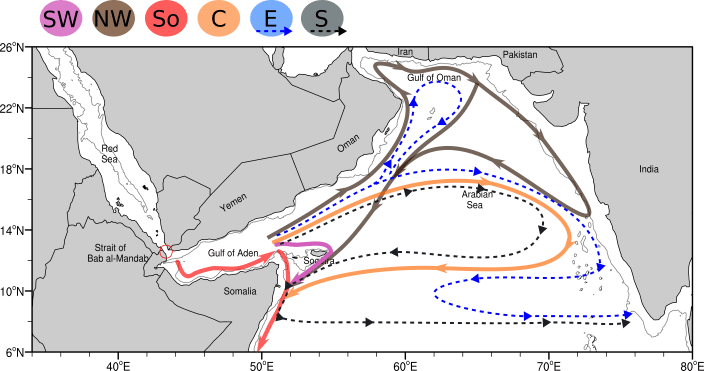Advective pathways and transit times of the Red Sea Overflow Water in the Arabian Sea from Lagrangian simulations
Menezes, V. V., 2021. Advective pathways and transit times of the Red Sea Overflow Water in the Arabian Sea from Lagrangian simulations. Progress in Oceanography, 199, 102697. doi: 10.1016/j.pocean.2021.102697.
The present study investigates the advective pathways and transit times of virtual particles released in the Red Sea outflow area as a proxy for the poorly understood spreading of the Red Sea Overflow Water (RSOW) in the Arabian Sea. The RSOW is one of the most important sources of salt for the oceanic intermediate layer and a source of oxygen for the oxygen-poor Arabian Sea, although the importance of the latter is still under debate. The Langrangian simulations were based on the eddy-rich GLORYS12 reanalysis that assimilates almost all in-situ and satellite observations collected over the last two decades. It is shown that GLORYS12 reproduces relatively well the climatological seasonal cycle of the RSOW to the Gulf of Aden and essential characteristics of the exchange at the Strait of Bab al-Mandab. Statistical comparisons between synthetic trajectories and RAFOS floats from the REDSOX project in the Gulf of Aden corroborate the quality of GLORYS12 velocity fields used for the Lagrangian simulations.
Six main advective pathways are uncovered (by order of preference): Southwest, Northwest, Socotra Passage, Central, Eastern, and Southern (see schematics). Trajectories from Argo floats give observational support for some of these paths. Although most particles are exported out of the Arabian Sea off Somalia, the simulations revealed robust connectivity of the RSOW to the Arabian Sea interior and its eastern boundary. Transit time distributions indicate that it takes about six months for particles to spread over the Gulf of Aden and one to three years to be exported along the western boundary– toward Somalia (Socotra Passage and Southwest pathways) and off the Yemeni-Omani coast (Northwest Pathway). In contrast, reaching the eastern boundary takes much longer. North of 14N, the most frequent time is around 10-15 years and about 20-25 years at the southeastern Arabian Sea.

